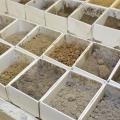Land Resource Areas
The formal definition of Major Land Resource Areas: Major land resource areas are geographically associated land resource units, usually encompassing several thousand acres, characterized by a particular pattern of soils, geology, climate, water resources, and land use. A unit can be one continuous area or several separate nearby areas.
How about in English? It is easy to pick out one Mississippi LRA by driving through it or flying over it. The alluviall Delta plain is obvious to spot. Soils were overwhelmingly formed by silt and clay deposition by the wandering Mississippi River. Many of today's "other" rivers in the Delta were Mississippi channels in earlier times, thus there is no simple pattern of deposition from the current channel. However, other factors associate the Delta into one resource area.
There are several major LRA's in the state described below (copied from the NRCS), however it is not always as easy to spot boundaries while driving down the road.
The Delta: Southern Mississippi Valley Alluvium
Land use: Most of this area is in farms. About 55 percent is cropland, 35 percent woodland, and 7 percent pasture. About 3 percent is used for miscellaneous purposes. Cropland makes up about three-fourths of the acreage in the north and less than one-fourth in the south. The proportion of forest land varies inversely with that planted to crops. The proportion of pasture is a little higher in the south. This is an important cash- crop area. Soybeans, cotton, and wheat grown by highly mechanized methods are the major crops throughout the area. Rice is an important crop in this region. Controlling surface water and artificially draining the wet soils are major concerns of management.
Soils: The dominant soils are Aquepts, Aqualfs, Aquents, Udolls, and Udalfs. They are deep, medium textured and fine textured soils that have an udic or aquic moisture regime, a thermic temperature regime, and mostly smectitic or mixed mineralogy. Fine textured Epiaquerts (Alligator, Perry, and Sharkey series), Hapludolls (Desha and Bowdre series), and Epiaqualfs (Jackport series), and medium textured Fluvaquents (Commerce, Mhoon, and Convent series), Natraqualfs (Foley series), Epiaqualfs and Endoaqualfs (Dundee, Amagon, and Hebert series), and Hapludalfs (Dubbs, Bosket, and Rilla series) occupy backswamp areas and older natural levees. Minor soils include moderately coarse textured Dystrochrepts (Beulah series) and Udifluvents (Robinsonville series), and medium textured Fluvaquents (Gideon series).
Southern Coastal Plain
Land use: This area is about 69 percent woodland, 17 percent cropland, and 11 percent pastureland. About 3 percent of the area is used for rangeland, urban development, or other purposes. The woodland is 65 to 75 percent privately owned and 25 to 35 percent industry owned. A small percentage is federally owned. Timber production is important. Cash crops include soybeans, corn, peanuts, and cotton. Major vegetable crops, melons, tobacco, and pecans are important in some parts. Recently, livestock farming has increased. Pastures are used mostly for beef cattle ' but some dairy cattle and hogs are raised. Controlling soil erosion and improving drainage on low wetland areas are major concerns of management.
Soils: The dominant soils are Udults. They are deep and have a thermic temperature regime, an udic moisture regime, a loamy or sandy surface layer, and a loamy or clayey subsoil. Well drained and moderately well drained, nearly level to strongly sloping Paleudults and Kandiudults (Bama, Dothan, Malbis, Norfolk, Orangeburg, Red Bay and Ruston series) are on uplands. Well drained, gently sloping to steep Hapludults and Kanhapludults (Cowarts, Smithdale, Springhill, Luverne, Saffell, and Sweatman in the south and Suffolk, Emporia, Rumford, Kenansville, and Craven in the north) are on uplands. Associated with these soils in less sloping areas are the moderately well drained and somewhat poorly drained, loamy Fragiudults (Ora, Bourne, Pheba, and Savannah series), Fragiudalfs (Dulac and Providence series), Paleudults (Izagora, Clarendon, and Goldsboro series) and the well drained to moderately well drained, clayey Paleudults and Kandiudults (Faceville, Greenville, Marlboro, and Shubuta series). Other well drained and somewhat excessively drained, nearly level to steep Paleudults and Kandiudults (Darco, Fuquay, Lucy, Troup, and Wagram series), which have a thick sandy surface layer, are on uplands. Less extensive, but locally important soils are the nearly level to moderately steep Quartzipsamments (Alaga, Kershaw, and Lakeland series) on uplands (mostly in the south), Paleudalfs (Atwood, Boswell, Millwood, and Susquehanna series) and Glossaqualfs (Caddo, Guyton, Mollville, Waller, and Wrightsville series) (in the southwest), Paleudalfs (Lexington series) on some loess-capped hilltops in the north-central part of the area, and nearly level Endoaquults (Amy, Myatt, Rembert, and Weston series), Albaquults (Cantey and Leaf series), and Paleaquults (Byars, Coxville, Pantego, and Plummer series) on low wetland. Floodplain soils include Udifluvents (Collins, Iuka, and Ochlockonee series), Fluvaquents (Bibb, Kinston, Mantachie, and Waverly series), and Dystrochrepts (Chenneby, Ouachita, and Riverview series).
Southern Mississippi Valley Silty Uplands
Land use: Most of this area is in farms. A small acreage is federally owned. About 35 percent of the area is cropland, but the proportion varies greatly from county to county, depending on the soils and the topography. This is largely a cash-crop area. Cotton, corn, soybeans, and wheat are major crops. Feed grains and forage are grown on dairy farms. About 16 percent of the area is in pasture or hay. About 46 percent is in forest of mixed pine and hardwoods. Lumber is the major forest product, and some pulpwood is harvested. The present trend is toward the conversion of the pasture and forest to cropland. About 3 percent of the area is used for urban development or other purposes. There is an increase in urban development near the metropolitan areas.
Soils: Most of the soils are Udalfs. They are deep, medium textured soils that have a thermic temperature regime, an udic moisture regime, and mixed mineralogy. Well drained, nearly level to very steep Hapludalfs (Memphis series) are on uplands. Moderately well drained, nearly level to strongly sloping Fragiudalfs (Grenada and Loring series) are on ridgetops, side slopes, and terraces. Somewhat poorly drained Fragiudalfs (Calloway series) and poorly drained Udifluvents (Morganfield and Vicksburg series), moderately well drained Udifluvents (Adler and Collins series), and somewhat poorly drained (Falaya series) are on flood plains. In the east, where the loess mantle thins, well drained Paleudalfs (Lexington series), moderately well drained Fragiudalfs (Dulac and Providence series), well drained Hapludults (Brandon, Smithdale, and Silerton series), and well drained Paleudults (Ruston series), all of which are gently sloping to steep, are on ridgetops and side slopes. Well drained Dystrochrepts (Ariel series), moderately well drained Udifluvents (Collins series), moderately well drained Dystrochrepts (Oaklimeter series) and somewhat poorly drained Fluvaquents (Falaya and Gillsburg series) are on the flood plains.
Blackland Prairie
Land use: In Mississippi, this area is about 58 percent woodland, 26 percent pastureland, and 14 percent cropland. Most soil areas have been disturbed, and only small remnants of the former prairie vegetation remain. About 2 percent of the area is used for urban development or for other purposes. Soybeans are the major crop, but corn, small grains, and cotton are also grown. Pastures are used mainly for beef production, but in some places dairying is an important industry. The woodland is about 75 to 80 percent privately owned, and about 20 to 25 percent is owned by industry. This is not a very productive woodland area. Controlling soil erosion and infestation of Johnsongrass on soils that are cultivated are major concerns of management.
Soils: The dominant soils are Ochrepts and Uderts. They are fine or very-fine textured and have a thermic temperature regime, an udic moisture regime, and smectitic or carbonatic mineralogy. They are mainly moderately deep to deep over soft limestone or chalk and typically shrink, swell, and crack. Well drained and moderately well drained Eutrochrepts and Hapluderts (Sumter and Maytag series) and moderately well drained to somewhat poorly drained Dystruderts (Oktibbeha and Vaiden series), all of which are nearly level to gently sloping and strongly sloping, are on wide ridgetops and narrow side slopes. Shallow Udorthents (Demopolis series) occur locally but are of small extent. Moderately well drained to poorly drained, nearly level to gently sloping Epiaquepts (Leeper series), Hapludolls (Catalpa series), and Epiaquerts (Eutaw and Sucarnoochee series) are in floodplains and in low upland areas. The outer perimeter of the area is intermittently ringed with moderately well drained to somewhat poorly drained Paleudalfs (Boswell and Searcy series) and moderately well drained and well drained Hapludults (Luverne, Sweatman, and Smithdale series).
Gulf Coast Marsh
Land use: Most of this area is in marsh vegetation and is used mainly for wildlife habitat. The area is almost treeless and uninhabited. It is part of the fertile and productive estuarine complex that supports marine life of the Gulf of Mexico. The area provides wintering ground for millions of ducks and geese and habitat for many fur- bearing animals and alligators. A significant acreage west of Vermillion Bay is firm enough to support livestock and is used for winter grazing of cattle. A small acreage of freshwater marsh is drained by pumping systems and is used for pasture and for the production of rice.
Soils: The dominant soils are Aquolls, Saprists, Aquents, and Hemists. They have a thermic temperature regime and an aquic moisture regime. Most of the soils of the Gulf Coast Marsh are very poorly drained, and the water table is at or above the surface most of the time. These soils are susceptible to frequent flooding. They formed in alluvial and marine sediments and organic accumulations. The Aquolls are firm, but the other soils are soft and can sustain little weight. West of Vermillion Bay, Haplaquolls (Harris series) are dominant. Soils with a thin surface layer of peat or muck and Medisaprists (Kenner, Lafitte, and Allemands series), Hydraquents (Gentilly and Scatlake series), and floating Medihemists (Carlin series) are dominant.
Eastern Gulf Coast Flatwoods
Land use: Very little of this area is in farms. Much of it is in large holdings owned by pulp and paper companies. Part of it is in state and national forests or is used as game refuges and for military training areas. Nearly nine-tenths of the area is forested. Pulpwood and lumber are the principal forest products. Some of the woodland is grazed. Only about 4 percent is cropped and a like amount is in pasture. Corn, peanuts, tobacco, and soybeans are the major crops. Some fruits and vegetables are produced, mainly for home consumption.
Soils: The dominant soils are Aquults, Aquepts, and Aquods. They have a thermic temperature regime and an aquic moisture regime. They are sandy and poorly drained or very poorly drained. Paleaquults (Plummer and Pelham series) have a loamy subsoil. Humaquepts have a dark surface layer. Alaquods (Leon and Mascotte series) have a weakly cemented layer at a depth of about 2 ft. Other important soils are sandy, moderately well drained and excessively drained Quartzipsamments (Chipley, Fripp, and Lakeland series), very poorly drained Sulfaquents, Sulfihemists, and possibly Hydraquents near the coast.
Land Resource Areas
Publications
News
Are you already thinking about what you will plant this spring and summer? If you are, don’t forget to test your soil. It’s the best way to know if your garden or lawn needs critical nutrients and how much.
Young people had the unique opportunity to learn interesting things about the soil, plants that grow in it and animals that feed on top of it at a recent field day.
Young people with an interest in soil science are encouraged to sign up now for a June 21 event that explores many aspects of this topic. Mississippi State University will host its first-ever Youth Soil Science Field Day at the North Mississippi Research and Extension Center in Verona. The half-day event is designed for students ages 8-12.



